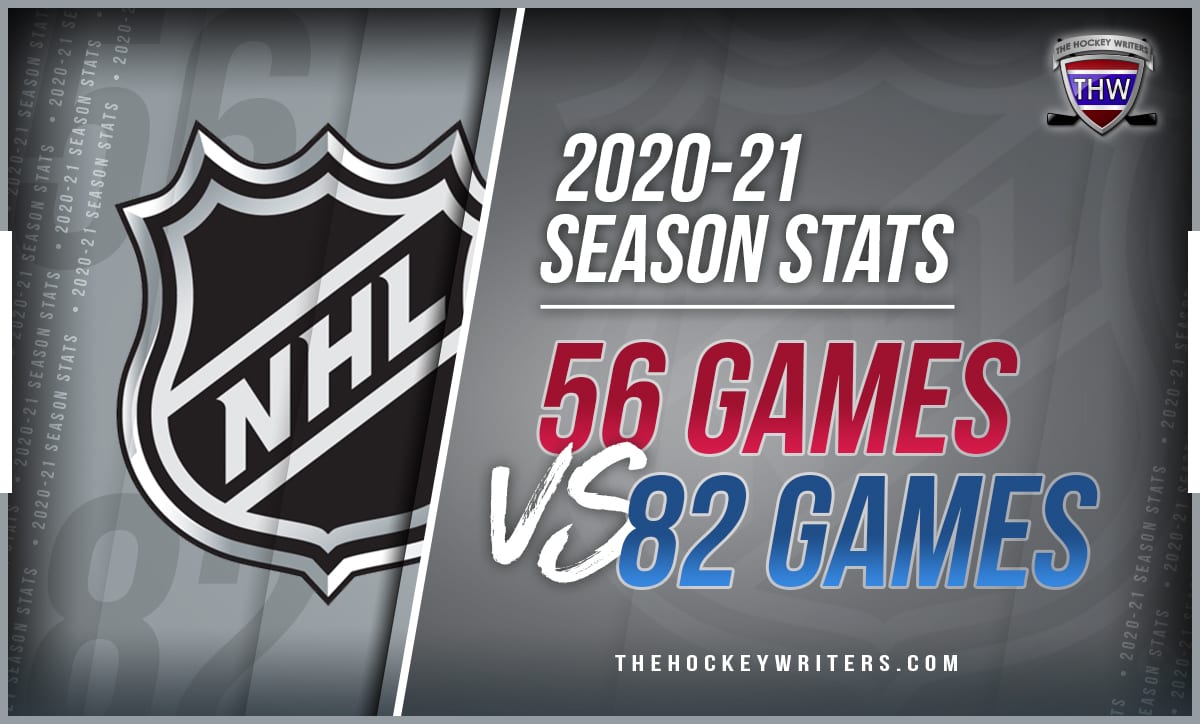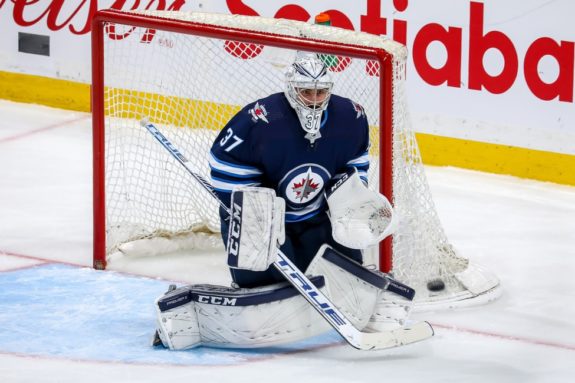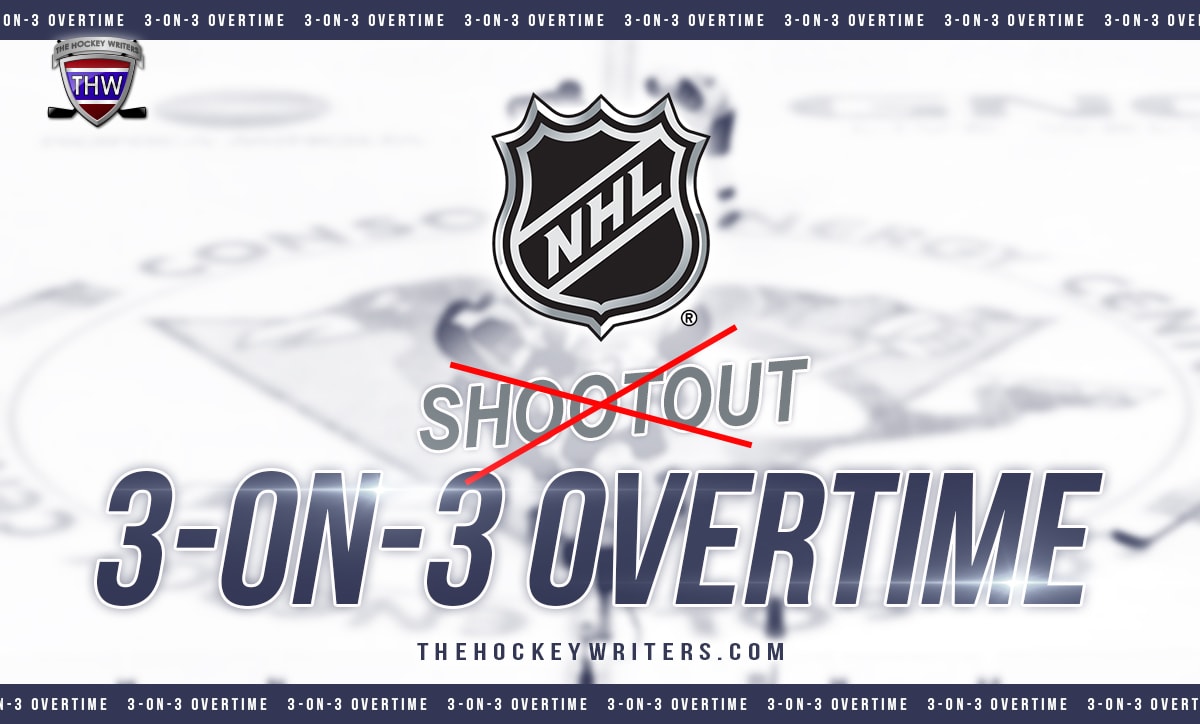The 2020-21 NHL season is one for the ages! At least we can hope that such a pandemic-shortened season is a one-time thing that we’ll never need to experience again. Re-aligned divisions, only intra-divisional play, the opening rounds of the playoffs within each division – it’s hard to compare 2020-21 to any other season in NHL history. But we can compare individual accomplishments from this season to others. It just takes a little math.

I’ve already done the math for you. We can see how a 56-game season’s performance compares to the same level of achievement over an 82-game season. (And we can see how the current season’s scoring leaders stack up against 82-game seasons, too.)
Pro-rating Major Individual Accomplishments to a 56-Game Season
Players scoring 50 goals! A break-out season of over 100 points! More than a half-dozen hat tricks! We’re not likely to see any player hit those numbers in a short season. But how many goals in a 56-game season would be equivalent to 50 in an 82-game season? How many points is comparable to 100 in a “normal” season? How many hat tricks would it take to be on-pace for top-15 all-time? (Take a milestone number for an 82-game season and multiply – not divide – by 0.683 to find the 56-game equivalent.) Let’s take a look:
- 50-Goal Equivalent: In a 56-game season, scoring over 34 goals is the equivalent of scoring 50 goals in an 82-game season. (Scoring exactly 34 goals this season falls a fraction short of 50.) In the six 82-game seasons since the shortened 2012-13 season, Alex Ovechkin has scored at least 50 goals four times. Leon Draisaitl is the only other player to reach the achievement (2018-19). In the COVID-shortened 2019-20 season, three players scored at a 50-goal pace for an 82-game season (not counting players who missed a substantial amount of games due to injury). At this point in the 2020-21 season, nine players are on pace for 50 goals in an 82-game season.
- 100-Point Equivalent: This season, a player hitting the 69-point mark would have been on a pace to break 100 points in an 82-game season. Remember that 100 points in a season used to be special. From 2013-14 through 2016-17, no more than one player hit the 100-point mark (none in 2014-15). In 2018-19, six players hit 100 points. In the short 2019-20 season, Draisaitl hit 110 points in only 71 games.
- Top-10 Hat Tricks in a Season: Wayne Gretzky scored 10 hat tricks in 1981-82 and again in 1983-84. Mike Bossy (1980-81) and Mario Lemieux (1988-89) both tallied nine hat tricks in a season. Brett Hull popped eight in 1991-92. Five players notched seven in a season, ranging from Cy Denney and Joe Malone (both in 1917-18) to Alexander Mogilny (1992-93). Any player recording five hat tricks in the shortened 2020-21 season would be on pace to join that exclusive club.
Trivia: Alexander Ovechkin is the active leader in NHL hat tricks with 27, but has never scored more than four in one season. He’s scored three hat tricks in a season – a hat trick of hat tricks – four times.

Keep in mind that these numbers won’t actually be extrapolated into the NHL record books. A player hitting 35 goals in 2020-21 won’t be credited with a 50-goal season. Likewise, that 35-goal scorer will have only his 35 actual goals added to his all-time individual statistics.
How Did My Favorite Player Stack Up?
When we get to the end of the season and you (or a player’s agent) want to compare a 2020-21 season’s scoring to an 82-game season, the math is basically reversed. At the end of the current 56-game season, multiply the player’s scoring stats by 1.464 to see what that pace would have accomplished in an 82-game season. (You might want to bookmark this page so you can refer back at season’s end for bragging rights among your fellow poolies.)
End of Season Standings
Now that all of the 2020-21 scheduled games have been played, we can see how things shook out for the league leaders
Related: Leon Draisaitl Telling His Critics They Can Stick It
Several players have started the 2020-21 with very strong performances. If they can maintain their current paces, here’s how they might look at the end of the current 56-game season and how those numbers would add up over an 82-game season.
Connor McDavid, Edmonton Oilers
2020-21 (Final Stats-56 Games): 33G-72A-105PTS
Original 56-Game Pace (After 13 Games): 39G-73A-112PTS
82-Game Pace: 38G-105A-154PTS
Leon Draisaitl, Oilers
2020-21 (Final Stats-56 Games): 31G-53A-84PTS
Original 56-Game Pace (After 13 Games): 30G-69A-99PTS
82-Game Pace: 45G-78A-123PTS
Mitch Marner, Toronto Maple Leafs
2020-21 (Final Stats-55 Games): 20G-47A-67PTS
Original 56-Game Pace (After 12 Games): 28G-65A-93PTS
82-Game Pace: 30G-70A-100PTS
Auston Matthews, Maple Leafs
2020-21 (Final Stats-52 Games): 41G-25A-66PTS
Original 56-Game Pace (After 11 Games): 51G-20A-71PTS
82-Game Pace: 65G-39A-104PTS
Amazingly, after their first 13 games, McDavid was actually on pace for 112 points in 56 games, an 82-game pace of 154 points. Matthews, after 11 games, was on pace for 51 goals in 56 games, an 82-game pace of 65 goals
Goalie Numbers Don’t Need Pro-Rating (Mostly)
Some statistics don’t need to be translated to an 82-game season. The major goalie stats, for example, are based on percentages and it doesn’t matter how many games they play. That’s normal – it allows us to compare goalies every season against their opponents (and teammates) who started or appeared in a different number of games. Goals-against average (GAA) and save percentage (SV%) are comparable from season to season because they are not dependent on number of games played.

There is one exception of note: the number of games required to qualify for consideration of awards and “bests.” In an 82-game season, a goalie must appear in a minimum of 25 games to be considered for the William M. Jennings Trophy, awarded for the fewest goals against. However, it’s actually awarded to the goalie or goalies who played at least 25 games for the team that allowed the fewest goals. A goalie who allowed a single goal in 30 games would lose out on that trophy if another team allowed fewer goals than did his own team during the full season. (However, that goalie would surely win the Vezina Trophy, award to “to the goalkeeper adjudged to be the best at this position.”)

I haven’t yet seen anything official on Jennings Trophy qualifications for 2020-21, but I expect it to be either 17 or 18 games played by one or more goalies on the team allowing the fewest goals. (Yes, in a 56-game season as many as three goalies can play in at least 18 games. And, likewise, three goalies could play at least 25 games for a team in an 82-game season.)
The Importance of Every Game in 2020-21
A couple of final notes: With only intra-division play and the first two rounds of the playoffs played within a division, the math for each game changes, too. Remember the saying, “a four-point game”? In a normal season, you will hear that phrase as the playoffs approach, when a team plays another team against which it is directly competing for a playoff spot.
A win for your team is a plus-two points in the standings, while for the opponent the game was, in effect, minus-two points – an opportunity to earn two points was squandered. Your team moves up the standings, while the other team stands still – one more game gone, one game closer to the end of the season, without any advancement in the standing. Now, with the new alignment and playoff format, every game is against a team competing with your team for a playoff spot. The 56-game math makes every game a four-point game.

Also this season, we’ll perhaps see more importance for the “loser point” and three-point games as teams fight for the final playoff spot(s) in their division. That extra point which is awarded to a team for finishing regulation tied, or (as some see it) that extra point awarded for delaying the loss of the game, may be decisive in which teams do and do not make the playoffs. So far this season, of 174 games played, 46 (just over 26%) included an extra point in the standing for the team that eventually lost the game in overtime or a shootout.
Related: NHL Should Eliminate the Shootout & Finish Games With 3-on-3 Overtime
Since that point in the standings for losing in overtime or a shootout will always go to a team in your division, whether your team played in that game or not, it might make the difference between battling for the Cup or hitting the golf course come mid-May.
From individual scoring accomplishments to qualifying for the Stanley Cup playoffs, the 2020-21 season is unique in the history of the NHL. We hope, it will remain unique and that we’ll never have to again experience a crisis such as the COVID-19 pandemic, with its impact not just on hockey, but on the lives and welfare of people around the world.
Statistics courtesy of the NHL, ESPN, and Hockey-Reference.com.